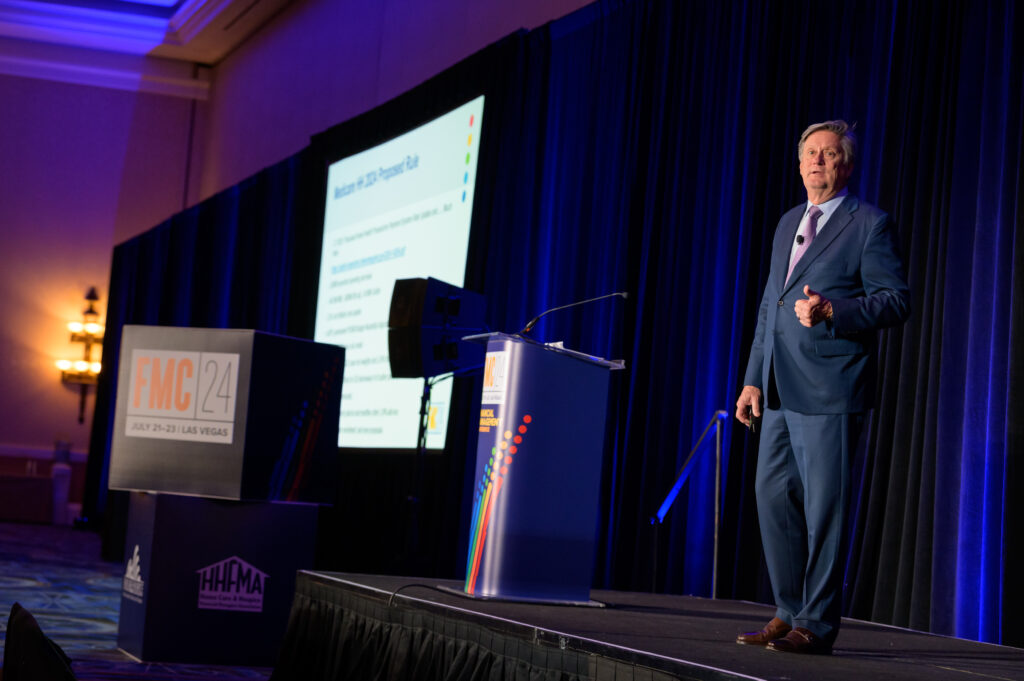As home health providers continue to digest the proposed payment rule for 2025, National Association for Home Care & Hospice (NAHC) President William A. Dombi believes that the industry will ultimately see a comparatively toned down final rule.
“We believe we will not end up with this proposed rule as a final rule,” he said during the opening presentation at NAHC’s Financial Management Conference in Las Vegas on Sunday. “We will end up with something less draconian. The cuts will be reduced because, No. 1, that’s what they’ve done for the last several years, and, No. 2, it’s an election year.”
Even with a prediction of a “less draconian” final payment rule, NAHC is still gearing up to fight against home health cuts and the Centers for Medicare & Medicaid Services’ (CMS) payment-setting methodologies.
“Our focus more than anything else is remedy coming by way of Congress,” Dombi said. “If we run the clock back 365 days, we had a Congress that was telling us, very overtly, ‘We will not help you.’ They were telling us that because they believed [providers] were making too much profit in the Medicare program. They were not understanding how the business runs. They weren’t understanding how any margin [providers] got was subsidizing other government programs like Medicaid and Medicare Advantage. They now understand it.”
Dombi credits a meeting the organization had with Sen. Ron Wyden (D-Ore.), which took place in Portland, Oregon and included five home health agency representatives from the state.
“Senator Wyden asked the question: ‘MedPAC says your margins average 22%, are those numbers wrong or has something changed?’” Dombi said. “One agency representative immediately spoke up and said, ‘the numbers are wrong and things have changed for the worse.’ He started explaining what happened within his home health agency. Now Senator Wyden is working with us to help us bring about some positive legislative changes.”
Dombi noted that there is already pending legislation.
Still, working with Congress isn’t the only way NAHC plans to address the issue. The organization is still moving forward on its plan to sue the Department of Health and Human Services.
“The action plan continues with this litigation,” Dombi said. “This litigation does not give us quick remedies. My estimate is if we succeed in the first round, we will be facing an appeal by the government. If we lose, they’ll be facing an appeal. Then there’s still the step above that — the U.S. Supreme Court. This kind of litigation may take many years to get through.”
However, Dombi believes that last month’s Supreme Court decision, which struck down the Chevron doctrine, may help NAHC’s lawsuit.
The proposed payment rule wasn’t the only issue highlighted during Dombi’s rundown of legislative and regulatory updates, however.
80-20 silver lining
The “Ensuring Access to Medicaid Services” rule also came under fire, specifically its 80-20 provision, which is controversial among providers.
Dombi pointed out that caregivers should receive higher compensation for their work, but NAHC doesn’t believe that the 80-20 provision is the right method to achieve this.
“We’re in agreement that the direct care workforce is underpaid and underappreciated,” he said. “We don’t agree that the solution is to say, ‘You have to pay 80% of your payment rate as compensation to that workforce,’ when the states are paying you at such an abysmal level for the service. There’s nothing in this rule that increases payment rates for the providers of services.”
There is, however, a silver lining to the provision. It doesn’t require compliance for the first six years.
“In Washington circles, giving that much of a glide path for something to take effect is almost a death sentence, so we expect that there’ll be a number of changes or it will be abandoned along the way,” Dombi said.
Despite the 80-20 provision, Dombi explained that the rule had other aspects that would be beneficial to providers, including more accountability for the states regarding payment rates.
Personal care sees more regulation
Dombi warned private-duty personal care providers not to fall into the trap of viewing the industry as being free of regulation.
“They may not be getting paid by federal or state governments, but they’re subject to a lot of rules and regulations, particularly under the Department of Labor,” he said.
Specifically, personal care is an industry that the department has its eye on when it comes to compliance with the Fair Labor Standards Act.
Aside from the DOL’s personal care focus, The Federal Trade Commission (FTC) also finalized a rule that effectively banned non-competes. Though this impacts all industries, Dombi noted that home care companies often rely on non-competes.
More recently, a federal court in Texas temporarily blocked the FTC’s non-compete ban. Dombi advised providers to follow these updates closely.




